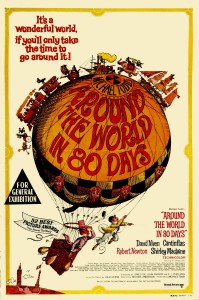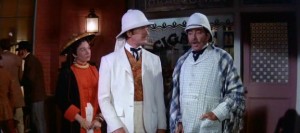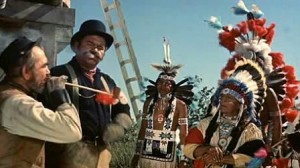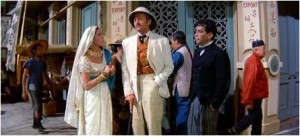My Life as Oscar Historian, 1986-Present
Around the World in 80 Days was the second adventure movie–after DeMille’s The Greatest Show on Earth, to win the Best Picture Oscar.
Grade: C+ (** out of *****)
The year was full of big-budget and prestige productions, such as DeMille’s bombastic biblical epic, “The Ten Commandments,” George Stevens sprawling Texas saga “Giant,” and the musical movie “The King and I,” all vying for the top prize.
Marking a turning point in Oscar’s history, 1956 was the first year in which all five Best Picture nominees were in color.
Mike Todd, who earlier helped the development of Cinerama, was not immersed in getting his own wide-screen process, Todd-AO, which produced sharper imagery than the previous innovation.
While Around the World was not the first film to use Todd-AO, it put the new technology to better effect into a globe-trotting travelogue that took audiences to exotic locales.
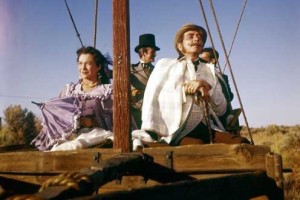 Though nominally directed by Brit Michael Anderson, it was Todd who actually put his stamp on the film, based on Jules Verne’s bestseller.
Though nominally directed by Brit Michael Anderson, it was Todd who actually put his stamp on the film, based on Jules Verne’s bestseller.
The rambling tale concerns a Victorian gentleman (David Niven) and his valet (Mexican star Cantinflas), who go around the world in 80 days on a wager.
Niven’s Phileas Fogg makes a bet with his fellow club members in London that he can encircle the globe in 80 days. Fogg is accompanied by his bumbling valet, and jointly they hit the road.
along the way, they meet or pick up an assortment of colorful figures, like a wandering princess (Shirley MacLaine), while being pursued by a London detective (Robert Newton), who believes that Fogg has robbed the Bank of England.
Using every possible means of transportation, they travel by train, ship, hot-air balloon, and even elephant across Europe, India, Japan, the U.S. and the Atlantic.
The film was budgeted at $7 million, way above the average at the time, and from the beginning, was touted as a spectacular event, with a running time of 175 minutes, rather than “just a movie.”
This was largely due to the over 100 settings and sets and Todd’s aggressive yet savvy publicity while the movie was being shot, allowing press on the set, and especially after it had premiered.
The adventure features over 50 cameo appearances of famous stars, such as Charles Boyer, Marlene Dietrich, Ronald Colman, Buster Keaton, Cesar Romero, and Frank Sinatra.
For many viewers, spotting the stars was the major fun. The movie set the trend of using big stars in small cameo roles, as was later demonstrated in the WWII epic “The Longest Day” in 1962, the Western anthology “How the West Was Won” in 1963, and the cycle of “disaster movies” in the 1970s, beginning with “Airport.”
The production was troubled from the get-go, when director John Farrow was fired and then replaced by Michael Anderson. The screenplay, eventually credited to James Poe, John Farrow, and S.J. Perelman, was also problematic. Todd was forced to abide by the ruling of the Writers Guild, when he tried to deny credit to Farrow.
Oscar Context
Nominated for eight Oscars, Around the World in 80 Days won five: Picture, Adapted screenplay, Color Cinematography, Editing, and Musical Score.
Perelman, better known as humorist and magazine pieces, had earlier penned the Marx brothers comedies, “Monkey Business” and “Horse Feathers”; Around the World became his last screenplay.
Composer Victor Young was nominated 21 times before finally winning the Oscar, which was awarded to him posthumously since he died just weeks before the Oscar ceremonies.
Michael Anderson, who took over from Farrow, began his career in England where he was assistant director on “Pygmalion” and “In Which We Serve,” two high-profiled movies that performed well in the U.S.
But his work after Around the World was not particualrly memorable or commercial, except for the sci-fi film, Logan’s Run.
Commercial Appeal
Around the World in 80 Days played for over one year in New York City alone. Ranking second among the year’s top-grossing films, following “The Ten Commandments,” the picture was the most commercially popular Oscar-winner until the historical epic “Ben-Hur” came out, in 1959.
Detailed Plot
Journalist Edward R. Morrow introduces the film with a prologue, featuring footage from A Trip to the Moon (1902) by Georges Melies, which is loosely based on Jules Verne’s celebrated book, From the Earth to the Moon.
In 1872, the English gentleman Phileas Fogg (David Niven) claims he can circumnavigate the world in eighty days. He makes a 20,000 pounds wager with four skeptical members of the Reform Club (each contributing £5,000 to the bet), that he can come back within 80 days.
Joined by his valet, Passeparout (Cantinflas), Fogg sets out on his journey from Paris by hot air baloon. Meanwhile, the suspicion that Fogg has stolen £55,000 from the Bak of England leads Police Inspector Fix (Robert Newton) of the Scotland Yard to trail and arrest Fogg.
Fogg pauses in Spain, where Passepartout engages in a comic bullfight, and in India, Fogg and Passepartout rescue young widow Princess Aouda (Shirley MacLaine) from being forced into a funeral pyre with her late husband. The threesome then visit Hong Kong, Japan, San Francisco, and the Wild West. But hours before winning his wager, Fogg is arrested at Liverpool by Inspector Fix.
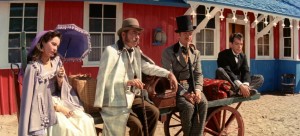 In jail, the humiliated Fix realizing he was misguided, informs Fogg that the real culprit was caught in Brighton. Though exonerated, Fogg has no time to get to London and has thus lost everything — except the love of the winsome Aouda. But the resourceful Passepartout claims that it is still Saturday. Fogg then realizes that by crossing the International Date Line, they have gained a day. In other words, there is still time to reach the Reform Club and win the bet.
In jail, the humiliated Fix realizing he was misguided, informs Fogg that the real culprit was caught in Brighton. Though exonerated, Fogg has no time to get to London and has thus lost everything — except the love of the winsome Aouda. But the resourceful Passepartout claims that it is still Saturday. Fogg then realizes that by crossing the International Date Line, they have gained a day. In other words, there is still time to reach the Reform Club and win the bet.
Indeed, Fogg arrives at the club just before the clock’s chime at 8:45 pm, and Aouda’s presence is shocking as no woman has entered the Club before.
